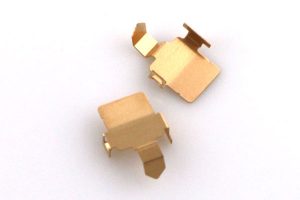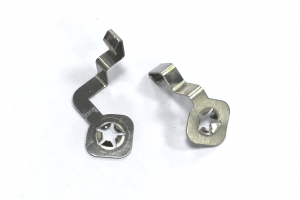Brief Analysis of Metal Contacts
The Definition of Metal Contacts
The metal contact is an important part of switches. Metal contacts are mainly used in thin-film switch, contact switches, PCB boards, FPC boards, medical equipment and other products. Among them, the contacts is the only metal component in the thin-film switch which is widely used.
The Materials and Parameters of Metal Contacts
Metal contacts are usually made of ultra-thin (0.05mm-0.1mm thickness) and ultra-thick (generally higher hardness) stainless steel 301 or 304 materials. Its thickness is 0.08~0.10mm, vickers hardness is 300~100. The main parameters of metal spring clips are as follows:
Lifetime: 1 to 3 million times
Strength: 1.5~4N
Stroke: 0.35~0.6mm
Operating temperature: 0~50℃
Rated current: 12mA
Rated voltage: 24V DC
Contact time: <10ms
The Common Types and Specifications of Metal Contacts
Generally, according to its different shape, we can divide regular metal spring contacts into four types: round metal contact, cross-shaped metal contact, triangular metal contact and oval metal contact. The diameter from 3mm to 20mm and strength from 100gf to 600gf. In addition to shape, we can also classify contact springs from its dimensions, operating force, stroke height and material thickness. Of course, we can also customize according to your drawings. In addition, according to the customer’s requirements for resistance, our metal spring contacts also has various surface treatments such as nickel-plated, silver-plated, and gold-plated.

The Working Principle of Metal Electrical Contacts
The electrical contacts on the membrane button is located on the conductive part of the PCB board (mostly located above the gold fingers on the circuit board). When pressed, the center point of the clips is concave and contacts the circuit on the PCB, thus forming a loop. When an electric current is applied, the whole product works properly.
The Function of Metal Contacts
- With the help of the electrical conductivity of metal, two-pole contacts of the switch are turned on.
- With the help of shrapnel rebound to provide tactile feedback to the operator.
The Application of Metal Contacts Springs
Metal electrical contact springs is mainly used in membrane switches of rigid boards such as printed circuit boards, which give full play to the three characteristics of conduction, rebound and hand feeling of contact spring. The application of the flat spring clips in the flexible membrane switch is mainly to provide tactile feedback (that is, feel), which is generally not used. That is to say, when the shrapnel moves, the switch contacts do not necessarily move at the same time. Moreover, in the flexible circuit board, the action of the spring clips often exceeds the level of its bottom. When the operating force is too large, it is easy to deform the shrapnel in the opposite direction and cannot recover. As a professional stamping manufacturer with over 30years precision stamping experiences, Our factory has advanced drumming equipment and technology to ensure even drumming and good hand feeling.
The Choice of Metal Spring Contacts
Choice of Spring Contacts Strength
- From the consideration of the size of the whole machine, the large equipment is also heavy and stable, and the latitudeis large when selecting the switch clips; For instruments that are smaller in size or lighter in weight, we should select metal clips with lighter strength to prevent the equipment from vibrating when the switch is operated.
- From the consideration ofthe operation direction, the vertical operation of the whole machine allows to use metal clips with greater strength; For a small whole machine that is operated in the horizontal direction, the clips with light force should be used as much as possible, otherwise the whole machine will be pushed and displaced due to the excessive operation force.
- From the consideration ofthe operating frequency, an excessive force of the metal clips will directly affect the speed of the operation. Therefore, for switches that are operated frequently, we should select a lighter, otherwise the operator will feel fatigued.
Choice of Spring Contacts Dimension
Contact spring should be large and not small. Wherever possible, use larger contacts clips. For the smaller one, the entire contacts is oppressed by external force during operation, and the edge portion of the contacts cannot restrain the rebound of the contacts, but is prone to irreversible deformation.
Analysis of Common Faults and Causes of Metal Spring Clip
Common faults:
The Action Between Metal Spring Clips and Switches are Different
Reason:
- The spring clips’ strength is too large;
- The spring clips’ travel is too high;
- The Isolation layer is too thick;
- The operating force is too small.
The Metal Electronic Contacts Can’t be Recovered
Reason:
- Improper selection of shrapnel;
- Shrapnel is too small;
- The Isolation layer is too thick;
- There is an adhesive layer between the contacts and the circuit;
- Excessive operating force.
Excessive Operation
Reason:
- Isolation layer is too thick;
- The hole in the separation layer is too small;
- Contact deviation;
- Shrapnel is not aligned with contact;
- Too thick panel;
- Shrapnel strength is high;
- Check vents, grooves.
The Rebound Hand is Not Obvious
Reason:
- The shrapnel strength is light;
- Panel lamination shrapnel;
- The shrapnel is restrained by the adhesive layer
SwitchShort Circuit
Reason:
- The shrapnel is overturned;
- The shrapnel is misaligned;
- The shrapnel gap is not aligned in the single-sided circuit board.

